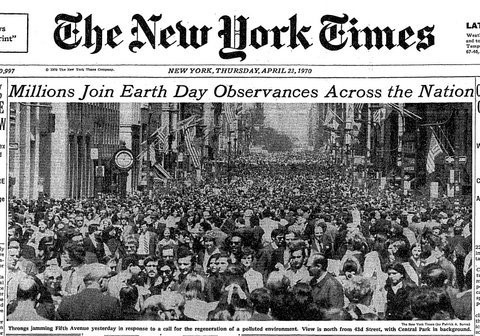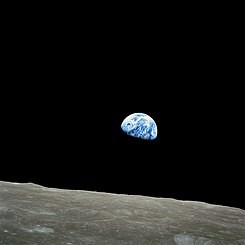Environment Focus
An environmental lens on policies for better lives
Why is the OECD looking at the environment?
By Anthony Cox, Deputy Director, OECD Environment Directorate
Usually, the most interesting questions come out of left field.
During the question and answer session at a conference on sustainable infrastructure last year, a young audience member asked the question: “Why is the OECD, an economic organisation, working on environmental issues?” At first blush, this question might seem to be trivial or provocative or uninformed, depending on one’s mood at the time. Nevertheless, it is actually a very good question to pose oneself every now and then, in the context of that broader existential question: “Why are we here?”
Of course, the standard answer rolls off the tongue quite easily, combining an assortment of key messages from our mission statement: the economy is actually a subset of the environment, not the other way round; the solutions to most, if not all, environmental problems require some form of policy intervention that will have an economic impact or cost; policy makers need to consider the costs and benefits of policies to address environmental problems; and so on.
However, it was also a prompt to look back at the history of the environment at the OECD to see where it started and how the environmental work has grown and evolved over the years. Drawing on the excellent book by the former OECD Environment Director, Bill Long, International Environmental Issues and the OECD 1950-2000: An Historical Perspective, this blog provides a potted history of the foundation of the environment work in the OECD.
The early focus of the OECD after its establishment in 1961 was on economic growth and increased productivity, and the word “environment” did not even appear in the first report from the OECD Secretary-General to the OECD Council in 1962. However, environmental issues began being tackled by the then Directorate for Scientific Affairs, focusing on the contribution of science to increasing growth and productivity. The first half of the 1960s saw reports produced on, amongst other topics, thermal insulation in buildings (1962), water pollution by detergents (1964), methods for measuring air pollution and aircraft noise (1964), pesticides in the environment (1966), innovation in urban management (1966), water basins (1966), and air pollution from auto exhaust and sulphur pollution (1967). An Environment Research Division was established in 1965 in the Directorate for Scientific Affairs.

The end of the 1960s saw a dramatic shift in the concerns of OECD Member countries. Major oil spills off the coasts of Cornwall in 1967 and California in 1969 focused public and political attention on environmental issues. This was boosted by the iconic photo, Earthrise, taken by astronaut Bill Anders during Apollo 8’s mission in 1969 (it has been deemed “the most influential environmental photograph ever taken”). Governments began to shift from a primary focus on stimulating economic growth to addressing concerns over resource scarcity, pollution, environmental degradation, and the qualitative aspects of economic growth. The increasing sophistication of the environment/conservation debate and growing grassroots activism coupled with the emergent influence of television to drive domestic and international political action. The First Earth Day was held in 1970, Greenpeace was created in 1971, the Club of Rome published The Limits to Growth in 1972, and the first UN Conference on the Human Environment was held in Stockholm in 1972.

Against this background, a landmark report in 1969 by OECD Secretary-General Lennep on “Problems of Modern Society” placed environmental issues as one of five sets of inter-related challenges for the future. This prompted the 1970 OECD Ministerial Council to give strong endorsement to strengthening the Organisation’s environmental capacity and programme, recognising that:
… governmental interest in maintaining or promoting an acceptable human environment must now be developed in the framework of economic growth. The Ministers agreed that the Organisation should pursue its work on environment by putting greater emphasis on economic and trade implications, relating this to qualitative objectives of growth policies and proposing concerted solutions to problems having substantial international implications. [C(70)125]
This led in short order to the establishment of the Environment Committee (re-named as the Environment Policy Committee in 1992), which held its inaugural meeting on 24-25 November 1970. The early years of the Committee saw a strong focus on pollution, with groups established to address issues in air management, water management, urban policy, chemicals, and waste management. The Environment Directorate was established in 1971 with a staff of 35 to support the Committee.
The focus from the outset was on deepening the understanding of the economic-environment relationship. Judging from the history recounted in Bill Long’s book, the pace was hectic and reflected the strong enthusiasm among leading researchers and government policy makers of the time to drive the agenda forward in response to rapidly growing environmental consciousness and concern throughout society. Without doubt, the most important product from the Committee’s early years was the OECD Recommendation Guiding Principles Concerning the International Economic Aspects of Environmental Policies. Adopted by the OECD Council in 1972 as the first legal instrument under the Committee’s purview, this Recommendation included the famous Polluter Pays Principle, an approach to assign to polluters the costs of goods and services that cause pollution and thus internalising environmental externalities. The Guiding Principles had a powerful influence on the Organisation’s work throughout the 1970s and beyond, and were instrumental in guiding national thinking about how to tackle environmental problems to ensure environmental effectiveness and economic efficiency. The first country environmental review was launched in 1973 with a study of Sweden’s (who else!) performance in relation to the Principles.
At the same time, the OECD was being called on to answer a key question that was becoming more prominent in national debates: “How much does it cost to protect the environment?”. Industry concerns over the financial impacts of environmental regulations, coupled with government concerns over trade and competitiveness impacts, generated the first wave of resistance to more active environmental policy settings. This prompted the OECD’s Economics Policy Committee to become active in the environmental field and, in 1971, to start looking into the macroeconomic implications of environmental standard setting.
The first Meeting of OECD Environment Ministers took place in November 1974 and was chaired by Mrs Gro Harlem Brundtland, Norway’s Environment Minister, who later became Norway’s Prime Minister and Head of the World Health Organisation (and author of the famous Brundtland Report, aka “Our Common Future”). The Ministerial meeting issued a Declaration of Environment Policy entitled “The World Environment 1972-1992: Two Decades of Challenge”, which was characterised as the first coherent statement on environmental policy by the industrialised nations. The Ministers also defined the priorities for the second half of the 1970s as: the energy-environment problem (reflecting concerns raised by the oil crisis of the early 1970s); long-term environmental hazards (e.g. polychlorinated biphenyls or PCBs and mercury); international aspects of environmental problems; and transfrontier pollution.
Since then, the OECD environment work has continued to grow in importance and influence. The Environment Policy Committee held its 100th meeting in September this year, there have been 11 OECD Environment Ministerial Meetings, and the Environment Directorate now numbers around 170 staff. Starting in the 1980s, the work programme broadened beyond the early focus on pollution and concentrated more on long-term, global-scale environmental issues such as CO2 and climate change, the ozone layer, acid rain, international movements of hazardous wastes, maintaining biological diversity, and environmental aspects of multinational investment and development assistance. These issues are at the forefront of global policy discussions in fora such as the UN, G7, G20, and APEC, just to name some of the key ones.
The issues have also become increasingly complex, with multiple, cross-cutting policy agendas at play, and many more stakeholders active in environmental discussions. This means that the imperative for a multi-disciplinary approach remains as high today as when the OECD first started working on the environment back in the 1960s.
[Interesting note: The OECD convened a Conference on Sonic Boom Research in 1970.]
For more information on the OECD Environment work programme, see: https://www.oecd.org/environment/brochure-oecd-work-on-environment-2019-2020.pdf
Further reading
Long, Bill L. (2000), International Environmental Issues and the OECD 1950-2000: An Historical Perspective, OECD Publishing, Paris.

